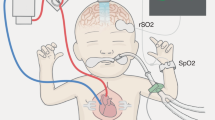Abstract
Background
Hemodynamic changes in the distal arteries during transfemoral catheterization in children have not been documented.
Objective
To evaluate arterial flow changes of the lower extremities ipsilateral to the puncture site using Doppler US during transfemoral cerebral angiography in children.
Materials and methods
Twenty-seven children who underwent transfemoral cerebral angiography at our institution between April 2013 and August 2013 compose our study population. Doppler US was performed to evaluate diameters and peak systolic velocities of the common femoral artery and superficial femoral artery before and after femoral sheath insertion. Children were classified into three groups based on the spectral waveform changes of the superficial femoral artery after femoral sheath insertion. Thereafter, one-way ANOVA followed by the Bonferroni post-hoc comparisons test were performed to compare values among the groups.
Results
Mean common femoral artery and superficial femoral artery baseline diameters were 4.10 mm and 3.32 mm, and mean baseline peak systolic velocities were 218.26 and 166.51 cm/s, respectively. Fourteen of 27 children showed persistent triphasic flow in the superficial femoral artery (group 1); 7 children showed altered flow of biphasic (n = 3) or monophasic (n = 4) waveforms (group 2); and 6 children showed pulsus tardus et parvus pattern (group 3) after femoral sheath insertion. Mean baseline diameter of the common femoral artery and mean subtracted value between common femoral artery and femoral sheath size were significantly smaller in group 3 than the other groups. Size discrepancy between common femoral artery and femoral sheath was <1 mm in all cases of group 3. Superficial femoral artery diameter and peak systolic velocity significantly decreased after femoral sheath insertion in group 3 compared to groups 1 and 2. A significant skin temperature drop after sheath insertion in the ipsilateral lower extremity was noted in group 3 (−1.83°C), compared to groups 1 and 2 (+0.42 and −0.86°C, respectively).
Conclusion
Changes in the spectral waveforms of superficial femoral arteries frequently occur in children during transfemoral cerebral angiography (13/27, 48%). Significant arterial flow disturbance was noted on Doppler US in children with a common femoral artery <1 mm larger than the femoral sheath diameter.


Similar content being viewed by others
References
Gross BA, Orbach DB (2014) Addressing challenges in 4 F and 5 F arterial access for neurointerventional procedures in infants and young children. J Neurointervent Surg 6:308–313
Mourot JM, Oliveira HM, Woodson LC et al (2009) Complications of femoral artery catheterization in pediatric burn patients. J Burn Care Res 30:432–436
Mori Y, Nakazawa M, Yagihara T (2010) Complications of pediatric cardiac catheterization and system of catheterization laboratories minimizing complications — a Japanese multicenter survey. J Cardiol 56:183–188
Knirsch W, Kellenberger C, Dittrich S et al (2013) Femoral arterial thrombosis after cardiac catheterization in infancy: impact of Doppler ultrasound for diagnosis. Pediatr Cardiol 34:530–535
Fullilove S, Fixsen J (1997) Major limb deformities as complications of vascular access in neonates. Paediatr Anaesth 7:247–250
Macnicol MF, Anagnostopoulos J (2000) Arrest of the growth plate after arterial cannulation in infancy. J Bone Joint Surg (Br) 82:172–175
Glatz AC, Shah SS, McCarthy AL et al (2013) Prevalence of and risk factors for acute occlusive arterial injury following pediatric cardiac catheterization: a large single-center cohort study. Cathet Cardiovasc Interv 82:454–462
Vitiello R, McCrindle BW, Nykanen D et al (1998) Complications associated with pediatric cardiac catheterization. J Am Coll Cardiol 32:1433–1440
Perings SM, Kelm M, Jax T et al (2003) A prospective study on incidence and risk factors of arteriovenous fistulae following transfemoral cardiac catheterization. Int J Cardiol 88:223–228
Chavhan GB, Parra DA, Mann A et al (2008) Normal Doppler spectral waveforms of major pediatric vessels: specific patterns. Radiographics 28:691–706
Wood MM, Romine LE, Lee YK et al (2010) Spectral Doppler signature waveforms in ultrasonography: a review of normal and abnormal waveforms. Ultrasound Q 26:83–99
Heran MKS, Marshalleck F, Temple M et al (2010) Joint quality improvement guidelines for pediatric arterial access and arteriography: from the Societies of Interventional Radiology and Pediatric Radiology. Pediatr Radiol 40:237–250
Carroll B (2005) The extracranial cerebral vessels. In: Rumack CM, Wilson SR, Charboneau JW (eds) Diagnostic ultrasound, 3rd edn. Elsevier Mosby, St. Louis, pp 943–992
Franken EA Jr, Girod D, Sequeira FW et al (1982) Femoral artery spasm in children: catheter size is the principal cause. AJR Am J Roentgenol 138:295–298
DuMond AA, da Cruz E, Almodovar MC et al (2012) Femoral artery catheterization in neonates and infants. Pediatr Crit Care Med 13:39–41
Conflicts of interest
None
Author information
Authors and Affiliations
Corresponding author
Electronic supplementary material
Below is the link to the electronic supplementary material.
ESM 1
(JPEG 2114 kb)
Rights and permissions
About this article
Cite this article
Kim, S.H., Choi, Y.H., Cheon, JE. et al. Transient flow response after femoral artery catheterization for diagnostic neuroangiography in infants and children: Doppler US assessment of the ipsilateral femoral artery. Pediatr Radiol 45, 86–93 (2015). https://doi.org/10.1007/s00247-014-3071-4
Received:
Revised:
Accepted:
Published:
Issue Date:
DOI: https://doi.org/10.1007/s00247-014-3071-4




